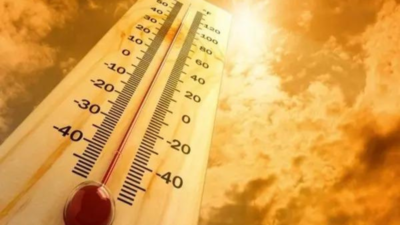- News
- India News
- Acute dryness in 125 districts, up from 33 in 2023, says IMD
Trending
Acute dryness in 125 districts, up from 33 in 2023, says IMD
According to IMD data from March 14-April 10, 2024, around 125 districts across 23 states and UTs in India are facing drought-like conditions, marking a significant increase from previous years. Some of the worst-affected states include Andhra Pradesh, Arunachal Pradesh, Gujarat, Haryana, Himachal Pradesh, Jammu & Kashmir, Karnataka, Maharashtra, Uttarakhand, and Tamil Nadu.

PUNE: Large areas of India are not only in the grip of increasingly dry conditions, but around 125 districts are also facing drought-like conditions, as per IMD data for March 14-April 10, 2024. The data marks a 279% increase from 33 districts in the same period of 2023 and a 27% jump from 98 districts in early March this year.
The 125 districts this time span 23 states and UTs, according to IMD's latest Standardised Precipitation Evapotranspiration Index (SPEI) data, which factors in temperature impacts on water demand.
Some of the worst-affected states are Andhra Pradesh, Arunachal Pradesh, Gujarat, Haryana, HP, J&K, Karnataka, Maharashtra, Uttarakhand and Tamil Nadu. Several districts in these regions are witnessing dry to extremely dry conditions.
Senior IMD scientist Rajib Chattopadhyay told TOI: "These districts have been categorised 'dry' with an SPEI value below -1. SPEI captures the main impact of increased temperatures on water demand. In a given region, as SPEI value dips below -1 it indicates increasingly severe rainfall deficits, signifying meteorological droughts. In contrast, only 16 districts across states such as Arunachal Pradesh, Bihar, Chhattisgarh, Odisha and West Bengal show wet conditions with SPEI greater than +1. When SPEI value climbs above 1, it signifies increasing wetness."
The 125 districts this time span 23 states and UTs, according to IMD's latest Standardised Precipitation Evapotranspiration Index (SPEI) data, which factors in temperature impacts on water demand.
Some of the worst-affected states are Andhra Pradesh, Arunachal Pradesh, Gujarat, Haryana, HP, J&K, Karnataka, Maharashtra, Uttarakhand and Tamil Nadu. Several districts in these regions are witnessing dry to extremely dry conditions.
Senior IMD scientist Rajib Chattopadhyay told TOI: "These districts have been categorised 'dry' with an SPEI value below -1. SPEI captures the main impact of increased temperatures on water demand. In a given region, as SPEI value dips below -1 it indicates increasingly severe rainfall deficits, signifying meteorological droughts. In contrast, only 16 districts across states such as Arunachal Pradesh, Bihar, Chhattisgarh, Odisha and West Bengal show wet conditions with SPEI greater than +1. When SPEI value climbs above 1, it signifies increasing wetness."
An SPEI map also highlights large areas of central, western and southern India covered in shades of yellow, red and orange (indicative of severity of dryness). These areas are experiencing heightened evapotranspiration rates. Evapotranspiration refers to the combined process of evaporation from Earth's surface and transpiration from plants. Essentially, it's the loss of water to the atmosphere from both these sources. Warmer temperatures increase the rate of evaporation from soil, water bodies and plant surfaces.
End of Article
FOLLOW US ON SOCIAL MEDIA











